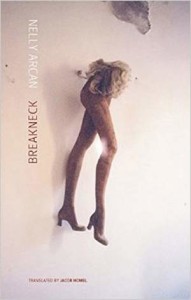Review by Carly Rosalie Vandergriendt
 Breakneck
Breakneck
Nelly Arcan
Jacob Homel, translation
Anvil Press, 2015
First published in French as À ciel ouvert in 2007, Breakneck is the last of Québécoise writer Nelly Arcan’s body of work to be translated into English, in this case by Montréal-born Jacob Homel. Through Arcan’s breathless, almost incantatory prose style, Breakneck presents the disturbing paradox of the female body in a world controlled by the male gaze. In its opening chapter, we are introduced to two rival protagonists whose ruthless pursuit of “industrial” beauty would make second-wave feminists keel over in horror.
Julie O’Brien, a documentary filmmaker, and Rose Dubois, a stylist, are both attractive, thirtysomething women with “bodies sculpted by…the violence of surgery.” (15) Over the course of the novel, they compete for the sexual attention of Charles Nadeau—personifying the male gaze as a professional photographer—in the heart of Montréal’s trendy Plateau neighbourhood. The power play between the two women appears to have little to do with Charles, and more to do with the women’s mutual desire to be the alpha female.
Through a shifting third-person limited perspective, Arcan carefully exposes her characters’ psychological scars. Julie, a recovering alcoholic and cocaine addict, fears that love will cause her to humiliate herself before Charles, as it did with an ex. Rose, who grew up neglected as a middle child in a family of five girls and one boy, theorizes that women greatly outnumber men the world over, a trend she observes in many a Montréal hotspot. As a result, Rose feels that, like all women, she has to “fight like a bitch to keep a man.” (76) Meanwhile, Charles’ fetish for “scars left like signs of entering…for implants, injected substances, hardening wounds, injuries of beauty beaten into the body…” (96) is spurred by childhood trauma at the hands of his psychopath father, a butcher. Weirder still is the fact that Charles’ relationships with women don’t actually involve penetrative sex. He seeks women like Rose, who are “made for sex, without sex.” (96)
Breakneck’s deceptively simple plot proceeds in a predictable fashion—referenced in the first pages, Charles’ accidental death in the final act should not come as a surprise to the reader. Even so, the story manages to be compelling in the way that sex scandals and murder trials are compelling. Arcan refuses to allow her reader to look away from uncomfortable truths. Her power is in leaving reality recognizable in the stark, sadistic world her characters inhabit, where the female body is a source of both shame and desire, simultaneously repulsive and arousing. Rose jokingly describes “Vulva-Women” as “covered with their own pussies, they disappear behind them.” (81) Julie, the more intellectually inclined of the two women, compares society’s “aesthetic obsession” with the female body to “a sort of Western burqa.” (80) These alarming ideas take on a symbolic form when Rose enlists her lovelorn plastic surgeon to help her construct the “Ideal Pussy.” The goal is to win back Charles, but also to give herself to all men as the ultimate image.
The participation of both men and women in the visual consumption of female bodies is familiar territory for Arcan. You might say it haunted her. Those who believe her conception of contemporary femininity is extreme, the expendable vision of a provocatrice, needn’t look farther than the author’s own experience with the media while promoting this book back in 2007. During her now-infamous encounter on the popular Québec talk show Tout le monde en parle, Arcan’s cleavage-baring dress garnered more airtime than her actual work, and was alternately praised by the male hosts as “very attractive” (“très alléchante”) and a regrettable choice, considering “the little girls who will want dresses like Nelly Arcan tomorrow” (“des petites filles qui vont vouloir des robes comme Nelly Arcan demain”). The disconcerting, twelve-minute clip reinforces the devastating idea at Breakneck’s core: “In all societies, from the most traditional to the most liberal, women’s bodies couldn’t be shown…The real body of women remained unbearable, fundamentally disturbing.” (162)
Carly Rosalie Vandergriendt is a Montréal-based writer of fiction, nonfiction, and poetry whose work has appeared or is forthcoming in The Malahat Review, Riddle Fence, and The Columbia College Literary Review. Visit her at www.carlyrosalie.com or follow her @carlyrosalie on Twitter.